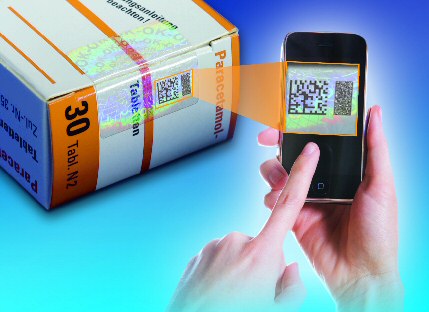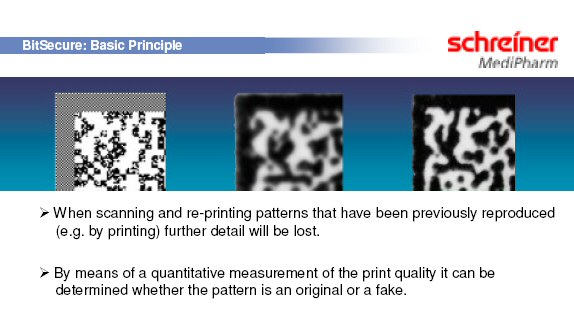Pattern makes 2D barcodes copy-proof
Phil Taylor, 15-Jul-2009
 German labelling specialist Schreiner ProSecure has acquired a digital authentication technology that can reveal if a document, label or product is an original or a copy.
German labelling specialist Schreiner ProSecure has acquired a digital authentication technology that can reveal if a document, label or product is an original or a copy.
Thomas Voelcker, marketing and sales director at Schreiner ProSecure, believes the technology provide a way to make 2D data matrix codes already in use on a number of pharmaceutical products copy-proof.
2D data matrix is gaining ground in pharma and of course at the centre of the serialisation pilot recently launched by the European Federation of Pharmaceutical Industry Associations (EFPIA) in Sweden.
However, while 2D data matrix is a robust system – the code can be read even if a third of it is damaged or missing – it is an open technology so can be copied by a counterfeiter.
“We wanted to find a technology that could be integrated with a 2D barcode and make it copy-proof,” Voelcker told SecuringPharma.com in a recent interview.
The company found what it was looking for in the BitSecure technology, originally developed by MediaSec Technologies, part of the Thomson Group. Schreiner acquired the platform for an undisclosed amount in March.
BitSecure takes the form of a high-resolution marking – approximately 3mm by 4mm – that could for example be printed alongside the data matrix code on a pharmaceutical package.
 The marking incorporates a tiny ‘noise pattern’ that is printed at extremely high-resolution. If copied – even with high-tech equipment - the information contained within the pattern degrades and is lost.
The marking incorporates a tiny ‘noise pattern’ that is printed at extremely high-resolution. If copied – even with high-tech equipment - the information contained within the pattern degrades and is lost.
That means patterns printed from the original source material – for examples the packaging artwork files printed by a brand owner - maintain the signal and can be authenticated at the same time as the 2D barcode using a standard scanner. Copies will not carry the encrypted signal, so will be identified as fake during scanning, even if the 2D code corresponds to a genuine product.
“This provides a simple way to combine the product identification via data matrix codes with a simultaneous authentication,” said Voelcker.
“The information stamp can be read using any type of optical scanning system, including a simple office flatbed scanner, or even by mobile phone provided it has an autofocus or a distance spacer is used,” he added.
The pattern has a minimum size of 12 square millimetres, but can be printed in different colours and shapes and so blend in with branding elements. It has already found applications in the real-world, including transport tickets, and was incorporated into the passes issued during the last FIFA World Cup.
In addition to printing the codes for clients, Schreiner also plans to license this technology to pharmaceutical brand owners and paperboard manufacturers, for example, which will then be able to laser engrave the code onto their products.
The pattern does not need to be carried on a label or cardboard pack, and there are applications where the authentication feature could be placed directly onto the product, said Voelcker.
For example, in the pharmaceutical sector, companies could create injection pens with the code directly incorporated into the plastic mould, or etched onto glass vials.

©
SecuringIndustry.com




 German labelling specialist Schreiner ProSecure has acquired a digital authentication technology that can reveal if a document, label or product is an original or a copy.
German labelling specialist Schreiner ProSecure has acquired a digital authentication technology that can reveal if a document, label or product is an original or a copy. The marking incorporates a tiny ‘noise pattern’ that is printed at extremely high-resolution. If copied – even with high-tech equipment - the information contained within the pattern degrades and is lost.
The marking incorporates a tiny ‘noise pattern’ that is printed at extremely high-resolution. If copied – even with high-tech equipment - the information contained within the pattern degrades and is lost. 